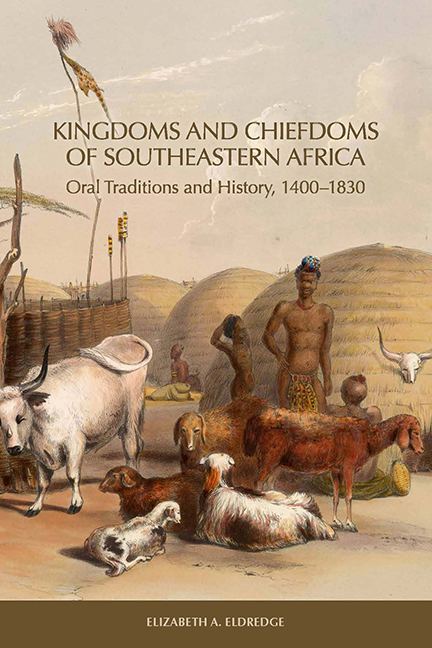Book contents
- Frontmatter
- Contents
- List of Illustrations
- Preface
- 1 History and Oral Traditions in Southeastern Africa
- 2 Oral Traditions in the Reconstruction of Southern African History
- 3 Shipwreck Survivor Accounts from the Sixteenth and Seventeenth Centuries
- 4 Founding Families and Chiefdoms East of the Drakensberg
- 5 Maputo Bay Peoples and Chiefdoms before 1740
- 6 Maputo Bay, 1740–1820
- 7 Eastern Chiefdoms of Southern Africa, 1740–1815
- 8 Zulu Conquests and the Consolidation of Power, 1815–21
- 9 Military Campaigns, Migrations, and Political Reconfiguration
- 10 Ancestors, Descent Lines, and Chiefdoms West of the Drakensberg before 1820
- 11 The Caledon River Valley and the BaSotho of Moshoeshoe, 1821–33
- 12 The Expansion of the European Presence at Maputo Bay, 1821–33
- 13 Southern African Kingdoms on the Eve of Colonization
- Appendix A Ama Swazi King Lists
- Appendix B Chronology of Conflicts, Migrations, and Political Reconfiguration East of the Drakensberg in the Era of Shaka
- Appendix C Interviewees from the James Stuart Collection of Oral Traditions
- Notes
- Bibliography
- Index
2 - Oral Traditions in the Reconstruction of Southern African History
Published online by Cambridge University Press: 14 March 2018
- Frontmatter
- Contents
- List of Illustrations
- Preface
- 1 History and Oral Traditions in Southeastern Africa
- 2 Oral Traditions in the Reconstruction of Southern African History
- 3 Shipwreck Survivor Accounts from the Sixteenth and Seventeenth Centuries
- 4 Founding Families and Chiefdoms East of the Drakensberg
- 5 Maputo Bay Peoples and Chiefdoms before 1740
- 6 Maputo Bay, 1740–1820
- 7 Eastern Chiefdoms of Southern Africa, 1740–1815
- 8 Zulu Conquests and the Consolidation of Power, 1815–21
- 9 Military Campaigns, Migrations, and Political Reconfiguration
- 10 Ancestors, Descent Lines, and Chiefdoms West of the Drakensberg before 1820
- 11 The Caledon River Valley and the BaSotho of Moshoeshoe, 1821–33
- 12 The Expansion of the European Presence at Maputo Bay, 1821–33
- 13 Southern African Kingdoms on the Eve of Colonization
- Appendix A Ama Swazi King Lists
- Appendix B Chronology of Conflicts, Migrations, and Political Reconfiguration East of the Drakensberg in the Era of Shaka
- Appendix C Interviewees from the James Stuart Collection of Oral Traditions
- Notes
- Bibliography
- Index
Summary
The oral traditions from the isiZulu-speaking people are a critical and central starting point for the reconstruction of much of the history of southeastern Africa. The success of the AmaZulu king Shaka and his successors in achieving political unification and dominance over a wide area ensured that their early genealogies and oral traditions of inheritance, migration, settlement, and peaceful and hostile interactions in the area were remembered into the twentieth century. Studies of the AmaZulu ruling line of descent and their followers have illuminated processes that included the subordination of peoples incorporated, both willingly and unwillingly, into the emerging Zulu kingdom in the late 1810s. The incorporated population was socially, politically, and culturally diverse, and the process was accompanied by internal social stratification. Records of the past, both written and oral, are more often preserved by rulers who have survived political upheaval, skewing the record in favor of those who have predominated. Fortunately, however, the oral traditions that James Stuart collected in the late nineteenth and early twentieth centuries included the distinctive histories of the many subordinated families, lineages, and chiefdoms whose identities came to be subsumed under the larger AmaZulu identity after the consolidation of the kingdom in the 1820s. In addition to the oral traditions recorded by Stuart, of critical importance are oral traditions and histories as well as personal observations recorded about early KwaZulu and precolonial “Natal” history by the early traders Henry Francis Fynn, Nathaniel Isaacs, and Charles Rawden Maclean.
Mandhlakazi told James Stuart that he should give great weight to whatever he heard from Mgidhlana ka Mpande about the royal house of Zululand by saying, “His words fill the mouth.” Stuart added the annotation, “That is, his talking is authoritative, final and so [therefore] complete.” In other words, Mandhlakazi was reporting Mgidhlana's reputation as an authoritative and fully credible source and in doing so indicated that the AmaZulu people were able to recognize and distinguish an authoritative source from someone who was not reliable.
- Type
- Chapter
- Information
- Kingdoms and Chiefdoms of Southeastern AfricaOral Traditions and History, 1400–1830, pp. 26 - 53Publisher: Boydell & BrewerPrint publication year: 2015

